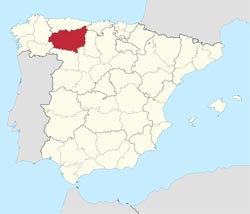León in León

The climate in León is relatively cool, and it is normally only between mid July and mid August that the temperature rises to or just above 30°C. The rainfall in the north averages 1,500 ml/m2 annually, but in the south, on the La Meseta, it rarely exceeds 500 ml/m2. The rain falls almost exclusively in autumn and spring.
The province consists of two mountain ranges, Cordillera Cantábrica and Macizo Galáico Leonés, and, in the central and southeastern part of the province, a tableland called La Meseta, which is at a height of between 700 and 1,000 meters.
 The province of León covers an area of 15 581 km2 has a population of 463,746(2018), 124,772 (2018) of whom live in the capital of the same name.
The province of León covers an area of 15 581 km2 has a population of 463,746(2018), 124,772 (2018) of whom live in the capital of the same name.
The name León is thought to stem from the Latin ‘legion’. The city was founded in its present position by a legion of Roman soldiers in the year 71 BC. In fact, even though the official adjective to describe people and things from León is ‘leonés’ and ‘leonesa’, the name ‘legionense’ (referring to the legion) is widely accepted.
The symbol of the city was originally a cross, but over time it has changed, and today a lion is depicted on the city’ coat of arms.
The Romans dominated León for about four hundred years, and there are still Roman remains in the city. However, the Romans were ousted, and first the Kingdom of the Suebi and then the Visigoths took over. There is very little architectural evidence from this period, and it is thought that the city was partly depopulated.
León fell into Muslim hands in 712, but it was soon conquered by Alfonso I. It sunk into oblivion for many years until it was repopulated by King Ordoño II of the Kingdom of Asturias, who
turned it into his capital.
This was the start of the Kingdom of León, and of a period of great prosperity for the city, evidence of which is still very much in place today in the shape of a great richness of architectural pearls from the era.
Some of the greatest examples of this are the Cathedral, Catedral de Santa MarIa de Regla and Panteón de 1os Reyes, where most of the kings of the Kingdom of León were laid to rest. The arched ceiling of the Pantheon have been called ‘the Sistine Chapel of the Romanic Art’.
Other sights of the city are the colourful Museum of Contemporary Art of Castilla y León, the old Town Hall and the former San Marcos Convent and Hospital. The Casa Botines, which was designed by GaudI and built in 1891-92, was constructed as a residential building with a warehouse. It is a fascinating building with many interesting details on the façade.
León’s economy has a wide base distributed between all three sectors. However, the primary sector has diminished over the last few years with the growing city imposing upon the land otherwise available for agriculture and livestock.
Industry has grown over the last 20 years due to the improved infrastructures leading to the city, and León has a budding, potentially important technological sector.
The tertiary sector, in the nature of the city being a capital, is mainly based on retail trade and services, but tourism is a growing factor due to the city’s rich architectural heritage, and León receives more than 600 000 visitors annually.


